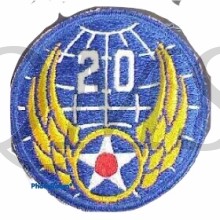Mouwembleem 20th Air Force (Sleeve patch 20th Air Force)
Established on 4 April 1944 at Washington D.C, 20 AF was a United States Army Air Forces combat air force deployed to the Pacific Theater of World War II. Operating initially from bases in India and staging though bases in China, 20 AF conducted strategic bombardment of the Japanese Home Islands. It relocated to the Mariana Islands in late 1944, and continued the strategic bombardment campaign against Japan until the Japanese capitulation in August 1945. The 20 AF 509th Composite Group conducted the atomic bomb attacks on Hiroshima and Nagasaki, Japan, in August 1945.
The Twentieth Air Force was brought into existence on 4 April 1944 specifically to perform strategic bombardment missions against Japan. This was done at the insistence of General Henry H. (Hap) Arnold, commander of the USAAF, mainly to avoid having the new B-29 Superfortress being diverted to tactical missions under pressure from theChina Burma India Theater commanders. Twentieth Air Force was to be commanded by General Arnold himself at Joint Chiefs of Staff level. Twentieth Air Force was completely autonomous and its B-29s were to be completely independent of other command structures and would be dedicated exclusively against strategic targets in Japan.
In addition Twentieth Air Force was chosen (secretly) to be the operational component of the Manhattan Project in 1944, and performed the atomic attacks on Japan in August 1945. However, in early 1944, the B-29 was not yet operationally ready. The aircraft had been in development at Boeing since the late 1930s and the first XB-29 (41-0002) flew on 21 September 1942. However, the aircraft suffered from an overwhelming number of development issues, and with engine problems (fires). As a result most of the first production B-29s were still held up at the Air Technical Service Command (ATSC) modification centers, awaiting modifications and conversion to full combat readiness. By March 1944, the B-29 modification program had fallen into complete chaos, with absolutely no bombers being considered as combat ready. The program was seriously hampered by the need to work in the open air in inclement weather, as many hangars were simply too small to house the aircraft indoors; by delays in acquiring the necessary tools and support equipment, and by the USAAF's general lack of experience with the B-29.
General Arnold became alarmed at the situation and directed that his assistant, Major General B. E. Meyer, personally take charge of the entire modification program. The resulting burst of activity that took place between 10 March and 15 April 1944 came to be known as the "Battle of Kansas". Beginning in mid-March, technicians and specialists from the Boeing Wichita and Seattle factories were drafted into the modification centers to work around the clock to get the B-29s ready for combat. The mechanics often had to work outdoors in freezing weather. As a result of superhuman efforts on the part of all concerned, 150 B-29s had been handed over to the XX Bomber Command by 15 April 1944.


